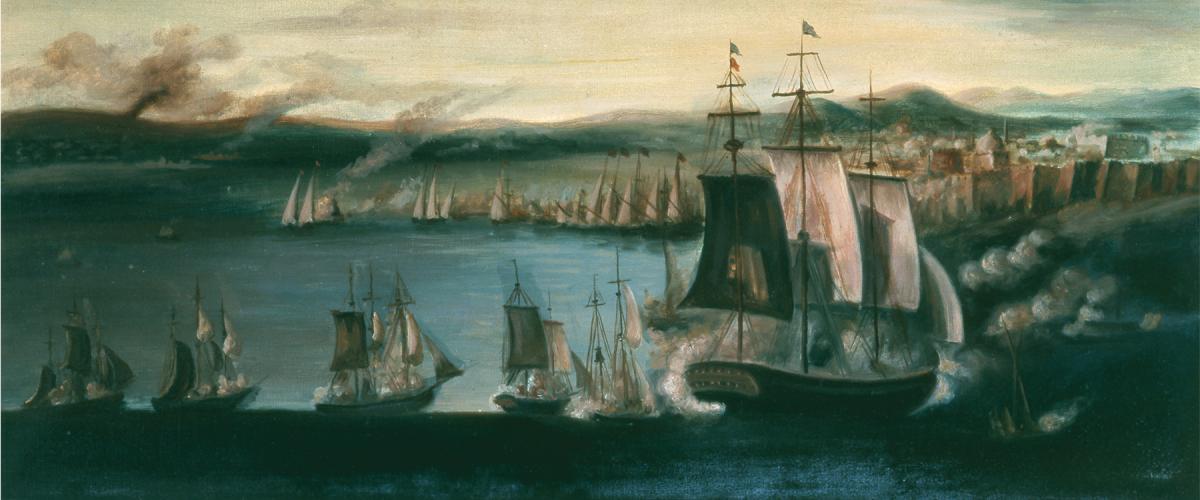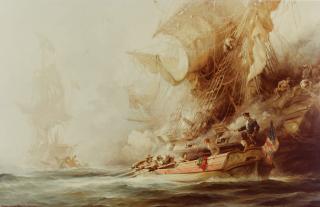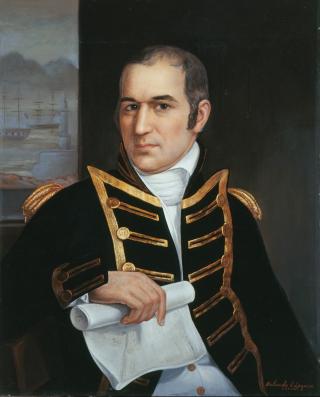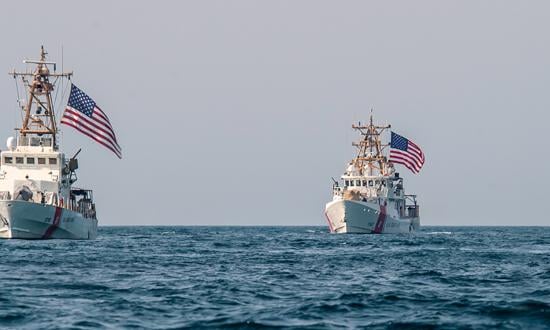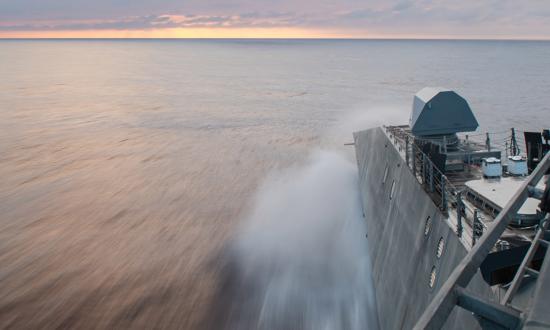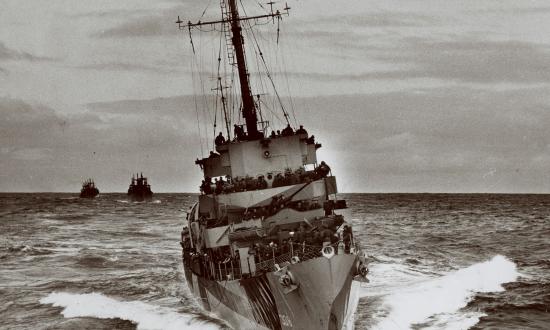Whether in the Black Sea, Baltic, or across the Indo-Pacific today, potential maritime adversaries have been developing abilities to achieve their goals below the threshold of war. Called “salami slicing,” maritime insurgency, gray-zone operations, or hybrid war, these operations, short of full-scale armed conflict, have ample historical precedent. While the Age of Fighting Sail can seem removed from the challenges of the 21st century, today’s strategists and naval professionals can learn a great deal from the period. The U.S. Navy’s conflict with Tripoli at the dawn of the 19th century—a maritime war between two smaller powers operating in the shadows of great empires—offers a deep view of maritime conflict and competition short of existential total war. From the importance of small combatants to the vital nature of partnerships, the First Barbary War (1801–1805) offers valuable insights in approaching competition and conflict in the gray zones of this century.
Countering maritime insurgencies in the gray zone is not a new mission—indeed it was the U.S. Navy’s founding mission. The force that would fight the First Barbary War was created in 1798 with the birth of the Department of the Navy for the express purpose of defending U.S. merchant shipping and seaborne commerce from a challenge to freedom of the sea. That challenge was posed by a great power in a key littoral region, without a declaration of war—namely, the threat posed by France in the Caribbean during what came to be known as the Quasi War. In a maritime competition that included elements of insurgency and episodes of outright combat, U.S. forces contended with many dynamics familiar to the contemporary operating environment: hostile use of private military contractors as irregular maritime forces (in France’s case, privateers), the pluses and minuses of working with partners and allies, and challenges maintaining effective maritime presence on distant stations. The gray-zone conflict between the United States and France resolved itself not through victory or defeat, but instead with a negotiated settlement in December 1800 to simply make the conflict “go away” as both sides realized it was distracting from their larger interests.1 Peace, however, was not what the rest of the world had planned for the young United States.
In May 1801, less than six months after the end of the Quasi War (1798–1800), Pasha Yousef Karamanli sent troops into the courtyard of the American Consul’s house in Tripoli to cut down the flagpole—a North African tradition symbolizing the declaration of war. Karamanli unleashed corsairs, as his Mediterranean privateers were known, on U.S. merchant ships and civilian mariners in the Mediterranean and eastern Atlantic. U.S. Navy ships and crews that sailed to the Mediterranean were largely the same ones that had fought the French, and they brought insights and combat experience from the previous conflict that they would apply to its second.
The Ships
During the Quasi War, Navy Secretary Benjamin Stoddert proposed a balanced navy with a squadron of ships-of- the-line supported by frigates and smaller vessels. However, the Peace Establishment Act, passed in 1800 by a Federalist Congress to protect some parts of the Navy from cost-cutting plans of the newly elected Jeffersonian Republicans, had sacrificed the largest planned capital ships as a political compromise to save the frigates that had served well against the French. The squadrons that deployed to the Mediterranean were made up of the Joshua Humphreys–designed super-frigates, traditionally sized smaller frigates, and small “unrated” combatants. Up against the small but nimble commerce raiders of the Tripolitan marine, the heavy, 44-gun frigates, such as the Constitution and the President, were overkill. Even the smaller 38- and 36-gun frigates, including the Philadelphia and Chesapeake, were large and easy to see coming, providing the Pasha’s corsairs ample opportunities to escape.
The first U.S. Navy squadron deployed to the Mediterranean, under the command of Commodore Richard Dale, included four frigates plus the 12-gun schooner Enterprise. She and her near-sister the Experiment were procurement and tactical experiments in the value of small combatants that had proved their worth, having made the most enemy captures across the entire U.S. fleet during the conflict with France. These and other smaller ships had played outsized roles in the Quasi War thanks to their ability to work the shallows and blend into local maritime traffic to maintain an element of surprise. Once deployed to the Mediterranean, the Enterprise had the first engagement and made the first capture of the Barbary War when Lieutenant Andrew Sterett and his crew defeated the Tripoli on 1 August 1801.2
After Dale was recalled, a second squadron deployed to the Mediterranean under the command of Commodore Richard Morris, bringing new ships but a similar force design centered on large frigates. Morris did not have much more success than Dale before being recalled himself; his lack of activity and questionable decision-making resulting in his court-martial and dismissal from service. When Morris was replaced by Captain Edward Preble as Commodore in 1803, however, the operations of the squadron changed both because of Preble’s aggressive leadership and also because the force design of the squadron changed. Unlike his predecessors, Preble’s squadron complemented the big frigates with a robust contingent of schooners and brigs, including the Enterprise, Vixen, Scourge, Nautilus, Syren, and Hornet.
These small combatants ranged the Mediterranean and played critical roles in Preble’s operations. Enforcement of the blockade on Tripoli was most often operationalized by pairing a frigate with a small combatant. The frigates provided the firepower and supplies needed to stay on station, while the schooners and brigs could use their speed and shallow draft to work closer to shore and chase down the enemy or deter them from leaving harbor. The utility of this approach was demonstrated not only by its successful application, but also by the dismal results when it was not employed—most notably when Captain “Bad Luck Bill” Bainbridge ran the Philadelphia aground in 1803. The mishap occurred while close to shore chasing a blockade runner, resulting in the capture of the frigate and its entire crew—the greatest single U.S. loss of the war. The reason the deep-draft Philadelphia was so close to shore as to strike the unmarked rocks was because Bainbridge had sent his speedy and shallow-draft consort Vixen on another mission. In contrast, when Preble was maintaining the blockade with the Constitution a few months later, he kept the Enterprise close, allowing the two ships to operate as a pair. When they discovered the ketch Mastico attempting to escape Tripoli harbor, the Enterprise’s shallow draft allowed her to head inshore and drive the Tripolitan ship out into blue water where she was compelled to surrender under the heavy guns of the Constitution. Preble and the Enterprise’s skipper, Lieutenant Stephen Decatur, renamed the captured ship the Intrepid.3
The Intrepid, commanded by Decatur and crewed with a raiding party of volunteers, made its famous nighttime attack on Tripoli to burn the Philadelphia a few weeks later. The mission was conducted as a team, with the Intrepid backed up by the 16-gun brig Syren, commanded by Lieutenant Charles Stewart. The Syren was able to blend in with the local merchant traffic and get in close enough to the harbor to provide the Intrepid vital support and supplies as Decatur and his crew fought their way out after setting the Philadelphia ablaze. While the Syren was small enough to get into the shallows to help the Intrepid, when a gale swept in as they made their escape, the brig was large enough to shepherd her partner through the dangerous storm.4
The small combatants soon became the utility infielders of Preble’s squadron. They convoyed U.S. and friendly merchant ships, moved supplies and dispatches between the squadron’s larger ships, fought close to shore during Preble’s attacks on Tripoli Harbor in summer 1804, and maintained the blockade. When William Eaton and his rag-tag army of Bedouins, mercenaries, and a small detachment of Marines began their march from Alexandria across the desert to Derna, the American small combatants were his lifeline. Landing supplies and money along the shore to help keep the mercenaries and tribal leaders going, the Navy’s logistical tail was critical to the combined army’s ability to make it to the outskirts of Derna. When they arrived before the city, it had been 25 days since they had any meat to eat, and 15 days since their bread ran out. Thankfully, they were met by the brig Argus and the sloop Hornet, which landed food and artillery to enable them to seize the town.5
Once Eaton and his forces were ready to begin their assault on Derna, the Argus and Hornet were joined by the schooner Nautilus, all under the command of Master Commandant Isaac Hull. The ships anchored themselves in key positions off the harbor’s fortress and provided the critical gunfire support Eaton’s army needed to rout the defenders. Once Lieutenant Presley O’Bannon and his Marines had raised the American flag over the fortress and allied forces secured control of the town, the small combatants began a rotation to retrieve supplies. The Navy’s support, both with guns and logistics, maintained the defense of Derna as Tripolitan reinforcements arrived to lay siege. While the Marines earned their memory and heritage on the “shores of Tripoli,” it was the Navy’s small combatants that provided the support necessary for success.
Small combatants were indispensable to operations in the shallows and were key to the Mediterranean squadron overall as Edward Preble turned disappointment and debacle into operational success against Tripoli. The squadron’s schooners, brigs, and sloops provided distributed protection to American merchants on the high seas, shallow-water capabilities and maneuverability, and the fire support and maritime logistics necessary for Eaton’s army to succeed. These operational capabilities remain deeply relevant today. Operations in the gray zones, archipelagos, and contested waters of the Indo-Pacific, particularly the “Asian Mediterranean” of the South China Sea, might benefit from a larger number of small combatants to complement the large surface combatants that comprise the bulk of today’s U.S. Navy. In addition to fulfilling key navy missions, those same small combatants would be critical to the work of Marine littoral regiments.
The Supporters
The First Barbary War is often remembered in U.S. naval heritage as an example of the fledgling service sailing alone and unafraid into dangerous waters, with European powers cast as self-interested or ineffectual against Tripolitan depredations against freedom of the sea.6 Yet reviewing the correspondence and reports of the officers who led the conflict, it becomes clear that not only were the Americans not “alone” in the conflict, but there are many examples in which the U.S. Navy’s success relied on the support of other navies and nations. The Royal Swedish Navy, the Kingdom of Naples, and even the British Royal Navy were all important partners at different junctures.
When Tripoli declared war in 1801, it had been preying on Western merchant traffic for decades, and the practice of corsairing between European and North African powers dated back nearly to the time of the Crusades. When Richard Dale’s squadron entered the Mediterranean for the first time, the kingdoms of Sweden and Denmark were already at war with Tripoli. The Americans arrived to discover ready partners.
As early as October 1801, the Swedes expressed their desire to “act in concert” with U.S. naval leaders as the first squadron began convoys in the Mediterranean.7 By December, the Danes were meeting with U.S. diplomats and exchanging intelligence on Tripoli and their negotiations with other Barbary states, including sharing naval plans.8 While the partnership with the Danes never provided more than information sharing, the Royal Swedish Navy operated directly with the Americans. The U.S. commodores and Swedish admirals coordinated who would be permitted to pass through the blockade on Tripoli and collaborated on naval diplomacy involving the rest of the Mediterranean.9 They went as far as to coordinate the deployment of their frigates to maximize coverage and enforcement of the blockade.10 The partnership between the Swedes and the Americans, however, only lasted for a year. Rear Admiral Cederström, commanding the Swedish forces in the Mediterranean, completed negotiations for a peace treaty with Tripoli in October 1802 with the assistance of Napoleon’s diplomats.
When Edward Preble arrived in command of the U.S. squadron, instead of Sweden he turned to the Kingdom of Naples for partnership. This kingdom was made up of the island of Sicily and portions of the peninsula that included the important ports of Naples and Livorno. Like Sweden, the kingdom had been at war with Tripoli for several years. Unlike the northern Europeans, however, Naples appeared to do very little about the conflict. Preble discovered that basing his ships out of the British strongholds of Gibraltar and Malta, as the previous commodores had, could result in logistical strain when Royal Navy ships in the Mediterranean arrived for resupply. Instead, he moved his main base to Syracuse on the eastern end of Sicily, where the governor offered port facilities and use of his armories, warehouses, and Admiralty court to support the Americans.11
Preble may be best known for his aggressive combat operations against Tripoli, but it was his naval diplomacy and work with partners that laid the foundations of those operations. After moving the American base to Syracuse, Preble expanded his collaboration with Naples. As he planned an assault on Tripoli harbor for the summer of 1804, he knew that while his heavy frigates provided good motherships and heavy guns for a littoral campaign and his small combatants would be important, he needed more and smaller gunboats to threaten Tripolitan forces deep within the harbor. Unable to obtain them from home, he visited Naples and entered discussions for Sicilian support. With the help of James Leander Cathcart, an American Consul living in Livorno, Preble convinced the king to provide not only gunboats, but also sailors to crew them under U.S. officers.12 The Sicilian gunboats, commanded by heroic officers including Stephen Decatur, Richard Somers, and James Decatur, played a critical role in the direct attacks on Tripoli in July and August 1804.
The other element that made U.S. attacks on Tripoli that summer possible was Preble’s work to establish a collaboration with the Royal Navy in the Mediterranean. While the British and French were taking a hiatus from their decades-long conflict under the Treaty of Amiens, the Royal Navy maintained a strong presence in the Mediterranean. Preble had already encountered issues with some British commanders, contributing to the decision to move his base to Syracuse. He worked hard, however, to maintain positive relations with British Governor Sir Alexander Ball in Malta and the commander of the Royal Navy’s station ship Captain Charles Schomberg. The British-controlled island was one of the closest ports to the shores of Tripoli. As Preble obtained his Sicilian gunboats and planned his summer assault, he knew logistics would be key to success.
Preble laid the groundwork for British support months earlier when he authorized passports to allow British ships to pass through the blockade from Malta to pick up cattle they had purchased to help feed their populace. When it came time to call in the favor, the British agreed to help the Americans with logistics for their squadron. William Higgins, the U.S. naval agent in Malta, received support from the government in helping him lease ships to carry supplies to the squadron while it remained on station in the Gulf of Sidra. Captain Schomberg even loaned the Americans casks from his warehouse to transport critical fresh water to the assault force.13
The development of partners in the First Barbary War is an often overlooked, but critical element of U.S. operations. William Eaton’s ability to cobble together a force of Bedouin tribes, mercenaries from southern Europe, and Tripolitan rebels for the march on Derna is relatively well known in naval history. Efforts of the American commodores to work with European powers in the region, on the other hand, is insufficiently recognized. Dale and Morris’s collaboration with the Swedes and the Danes, and Preble’s naval diplomacy with the Sicilians and the British, were important elements of how the Americans planned and executed everything from blockade to convoys, to attacks on Tripolitan forces. The naval leaders were also in a vital collaboration with State Department Consuls and civilian naval agents. Far from fighting the Barbary corsairs alone, partnerships with European naval forces were vital to U.S. success.
The Right Ships and Supporters for Maritime Competition
U.S. Navy operations during the war with Tripoli were about much more than ships fighting and sinking other ships. The conflict spanned a range of naval operations from convoys and commerce protection to blockade, bombardment, and support for boots on the ground. The commerce-raiding conflict launched by the Tripolitans, a kind of maritime insurgency, required a response in kind. This meant the U.S. Navy needed to conduct maritime security patrols, support a counterinsurgency ashore against Pasha Karamanli, and launch attacks and raids on Tripoli’s ships, harbors, and land targets. These key elements of naval strategy required more than just ships-of-the-line, built to stand in combat against great power navies of the world. They required a balanced force design and partnership with other navies and nations for the Americans to be successful.
These precepts of naval statecraft during the Age of Sail remain relevant for U.S. strategists and commanders seeking effective approaches to defend the freedom of the sea from the maritime militias and coastal forces of China or Russia today. Now, as then, success depends on the ability to mesh diplomatic partnerships with the deployment of balanced naval forces, combining both large combatants ready for high-intensity combat and smaller combatants and craft able to conduct distributed operations and wage lower-intensity competition. In 2009, then-Commander Jerry Hendrix suggested creating what he called “influence squadrons,” and in an August 2022 Proceedings article for this series, Captain Josh Taylor described a task force centered on a large expeditionary mothership and comprised of offshore patrol vessels for operations in the South China Sea.14 Such creative fleet architectures would be recognizable to Commodore Preble were he alive today.
The U.S. Navy and Marine Corps have faced maritime insurgencies and gray-zone competitors since their formative days. U.S. sailors and Marines have succeeded against such threats before, and, by applying insights from the past, they can do so again.
1. Benjamin Armstrong, “‘Things Done by Halves’–Observations from America’s First Great-Power Competition,” Naval War College Review 73, no. 4 (Autumn, 2020), 67-84.
2. Howard Chapelle, The History of the American Sailing Navy: The Ships and Their Development (New York: W. W. Norton, 1947), 145-47. “To Richard Dale from A. Sterett, 6 August 1801,” Dudley W. Knox, ed., Naval Documents related to the United States Wars with the Barbary Powers, Vol. 1 (Washington D.C.: Government Printing Office, 1939), 537.
3. A.B.C. Whipple, To the Shores of Tripoli: The Birth of the U.S. Navy and Marines (Annapolis: Naval Institute Press, 2019), 131–33.
4. Benjamin Armstrong, “The Most Daring Act of the Age–Principles for Naval Irregular Warfare,” Naval War College Review 63, no. 4 (Autumn, 2010), 110–112.
5. Whipple, To the Shores of Tripoli, 229.
6. Brian Kilmeade and Don Yeager, Thomas Jefferson and the Tripoli Pirates: The Forgotten War that Changed American History (New York: Sentinel, 2015). Many elements of Kilmeade and Yeager’s conclusions, including the questionable comparison to modern day Islamic extremism and the labeling of the Tripolitans as “terrorists,” are ahistorical or anachronistic.
7. “To William Eaton from N. Frumerie, 14 October 1801,” Knox, Naval Documents, Vol 1, 599.
8. “To James Madison from William Eaton, 13 December 1801,” Founders Online, National Archives.
9. “To James Madison from James Simpson, 19 March 1802 (Abstract),” Founders Online, National Archives.
10. “To Thomas Appleton from Richard Dale, 25 Jan 1802,” Dudley W. Knox, ed., Naval Documents related to the United States Wars with the Barbary Powers Vol. 2 (Washington D.C.: Government Printing Office, 1940), 28. “To Secretary of the Navy from Captain Alexander Murray, 5 July 1802,” Knox, Naval Documents, Vol. 2, 192.
11. Whipple, Shores of Tripoli, 130–31.
12. Benjamin Armstrong, “Against the Common Enemies: American Allies and Partners in the First Barbary War,” in Peter Hore, ed., The Trafalgar Chronicle, New Series 2 (Annapolis: Naval Institute Press, 2017), 51–54.
13. Armstrong, “Against the Common Enemies,” 56–57.
14. Commander Henry J. Hendrix, USN, “Buy Fords, Not Ferraris,” U.S. Naval Institute Proceedings, 135, no.4 (April 2009), and CAPT Joshua Taylor, USN, “A Campaign Plan for the South China Sea,” U.S. Naval Institute Proceedings, 148, no.8 (August 2022).



